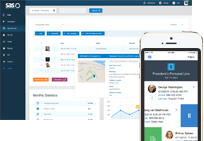- Log In
- Support
- Company
- Contact Us
- Live answers @ 1-888-532-4794
6 Steps To Build A Personal Answering Service
While just using an answering service is important to the success of any small business – cost cutting, 24/7 live customer service, and all that good stuff – there’s another important aspect of using an answering service you may be missing.
Developing your account to create more personal interactions is what’s really going to lead to the most successful outsourcing experience for both you and your customers. For a small business or a startup who has never used an answering service, getting the right mix of knowledge to the virtual receptionist can be the difference between outsourcing success and failure. That’s why it’s essential to develop your script and/or choose the right receptionist style that will represent your business the best.
Step 1: Understand your options and avoid scripting pitfalls
Your approach to scripting should be different depending on if you’re using an answering service or a call center. For example, a standard answering service is typically set in a non-scripted environment, meaning that the operators handling your calls will have a general outline of the questions to ask or information to gather, but they do not have to follow an actual script, whereas a call center service is set in a scripted environment where the operators are required to closely follow a script in order to get through a call.
Once you have a clear understanding of your options and you’ve decided on the type of service that will work best for you, the next building block to creating a personal answering service is to avoid scripting pitfalls. Often, when businesses sign up for an answering service, they try to set up their call handling the same exact way their calls are handled in-house. While it is important to make sure your service and your business are working in tandem, it may not always be feasible to set them up exactly the same way. Here are some ways to avoid errors:
- Arm your answering service with 5-10 frequently asked questions that your operators can easily answer.
- Add a driving question upfront to help steer the call and avoid callers from rambling.
- For complicated scenarios or irate callers, set up a warm transfer to your in-house support team.
Tip: When setting up your account, consider the customer experience first. For example, having your answering service get deeply involved with asking multiple questions will probably lead to more questions on the caller’s side, which your operators probably will not be able to answer.
Step 2: Know who is answering your calls
Taking advantage of any level of a free trial period is a great way to get to know who is answering your calls before you start to open up all of your traffic. A free trial gives you and your team the freedom to place test calls as if you were an actual caller so that you can get an idea of what your callers will experience. It also provides a great opportunity to see what’s working or what doesn’t flow so well so that you can make the appropriate scripting adjustments. When you do finally send calls over, you can be confident that everything will already be running like a well oiled machine.
Aside from the mechanics of the call, you want to make sure that the customer service representatives answering your calls are representing your brand as perfectly as someone in your own office would. The more you work with your answering service and express your goals and ideas, the more they can customize your account to fit your needs as closely as possible.
Tip: Continue placing test calls throughout the duration of your time on service so that you can always stay in the loop and address issues as they come up instead of waiting to hear about them from your customers.
Step 3: Work closely with your customer service team
Having a good relationship with your answering service’s customer service team is important, as they are the ones that will help guide you whenever you need help or have questions. Working closely with your service encourages everyone involved to be on the same page, which makes the process of bouncing ideas and making updates that much easier. When your service is aware of your goals and has your business’s success in mind, you are able to maximize your outsourcing experience and ensure your customers are always receiving personalized care.
Tip: Schedule monthly script reviews with your answering service to make sure everything is still running smoothly. If anything happens to change within your business (like pricing, services, etc.) make sure your answering service is aware.
Step 4: Adjust your protocols to remove interactions that feel cold
Once you get the initial blueprint designed and script built, you might find that some protocols you have in place just don’t flow naturally. Questions or protocols that may have been important for you to include in the beginning may not be as necessary if you see that callers are having a hard time understanding, or your invoices are getting too high due to the length of your calls.
The most important aspect to consider when working with your answering service is how your customers will feel about their experience. Asking question after question can feel monotonous and may wind up frustrating callers more than helping them. If your customers are hesitant to reach out when they need you, take that as a cue that something needs changing.
Step 5: Look at the data
Just like you would monitor the quality of service and ask for feedback from customers in regards to your own office and staff, applying the same mindset to your answering service can help you build a more personal experience. Below are some easy ways to gather insight which can help determine how to fine tune your service:
- Listen to recordings: Being able to listen to how your calls are handled is a great way to see how things are operating, and if anything needs updating. If operators are consistently stumbling over the same area, consider removing or re-wording the question. If your callers are getting confused about who they are talking to, consider adjusting your call handling so that the operators are announcing they are with the answering service when they greet callers.
- Monitor hold times: Being on hold isn’t great, but it’s inevitable. However, you can easily monitor hold times by placing test calls yourself or requesting answer rate reports from your service. These reports should show you how many calls hit your system in a given time frame, and how long each one of them waited. If you notice that you have frequent holds, adding a custom hold message will help deter callers from abandoning the queue. You may even want to see if your service can set up a system that allows operators to call back customers who have hung up before reaching anyone, which will help personalize your customers’ experiences.
- Let customers rate the operators: Getting into the mind of your customers is a great way to gather feedback. After each interaction, have your answering service send an email to your callers asking them how they did. This provides a great opportunity to see what’s working, and what needs tweaking. And, your callers will love the extra touch of customer service!
- Run reports: Running reports and collecting data will help determine various metrics like when you have the highest volume of calls or the reason why customers are calling, which will help you make adjustments to better streamline support.
Step 6: Eliminate automation
For your customers to feel a personal connection to your company, they should be speaking to actual people. While automated systems can come in handy, the best type of support is live support. If you currently have a voicemail set up to catch after hours or overflow calls, or you have a complex auto attendant set up with 37 options, your business is only going to succeed in giving off the feeling that you don’t really want to talk to your customers.
Allowing your callers to talk to a warm body instead of a cold robot helps show that your business is powered by humans, which is much more relatable to your customers, who we assume are also human.
Tip: If you do need to use a voicemail, include your answering service’s forwarding number in your message so that your customers have the option to call them directly if they need to speak with someone. Additionally, if you need to use an auto attendant, make it simple and straightforward so that your callers can still receive live support easily.
Categories
- Advice (32)
- Answering Service 101 (18)
- Best Practices (10)
- Call Center Jobs (6)
- Call Center Software (20)
- Comparison (2)
- Customer Service (30)
- Funny (31)
- Holidays (19)
- Industry Hacks (19)
- Infographics (53)
- International (1)
- Medical (8)
- News (12)
- Phone Etiquette (2)
- Phones (14)
- Pricing (8)
- Quizzes (3)
- Receptionist (11)
- SAS Products (29)
- Scripting (4)
- Services (5)
- Small Business (25)
- Starting Up (7)
- Tips and Tricks (19)
- Uncategorized (1)
- Videos (19)
- Workplace (6)
Recently writen
- Call Center Script Best Practices: Advanced Script Block Tips to Optimize Your Answering Service
- January 2025 Release Notes – Adjustments to Call Details Timeline, New Scripting Updates, Live Transcription, and more!
- April 2024 Release Notes – Voicemail Greetings, Ability to Access Websites With a Username and Password, and more!
- March 2024 Release Notes – New Add-On, Settings Revamp, and more!
Follow Us
How about a demo?
We'll show you how our web portal works and answer any questions you have about SAS.
Schedule a demo







